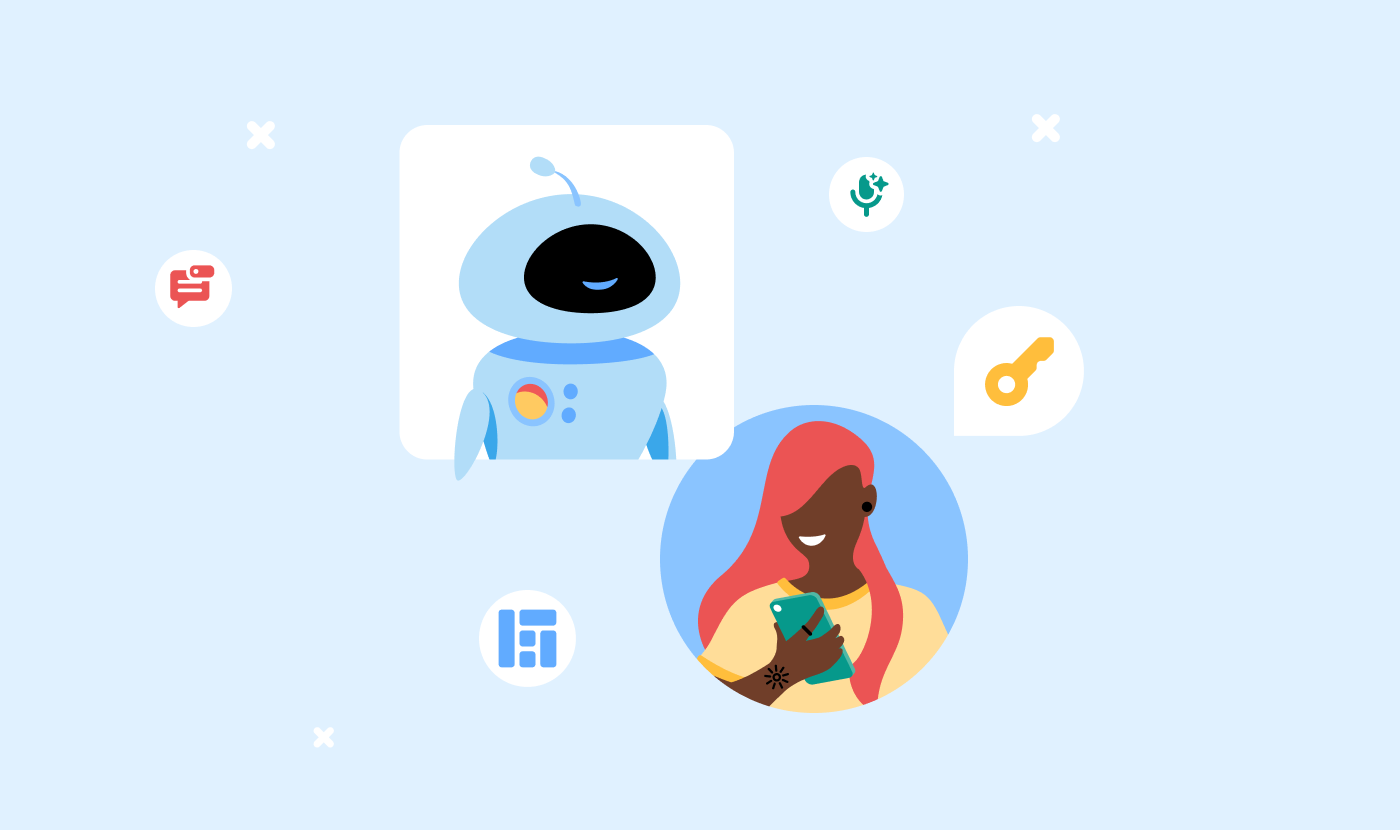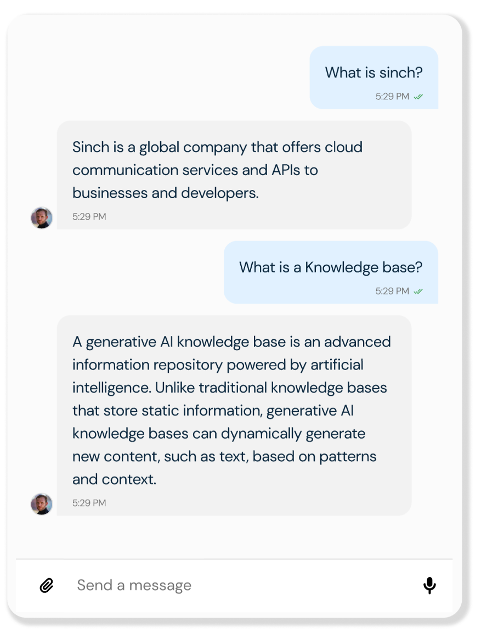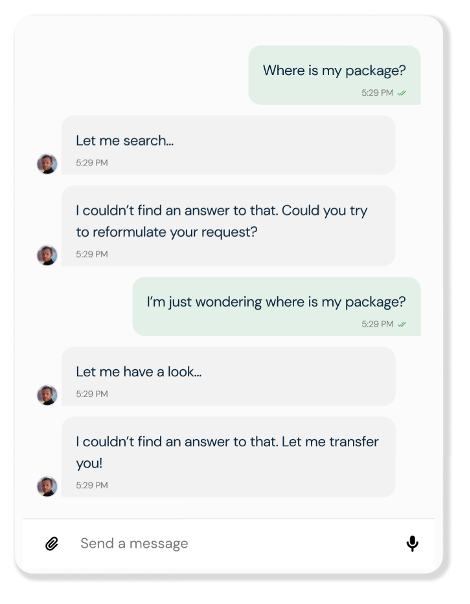Conversations, Insights
3 types of bot technologies and how to choose the right one for customer support

Conversations, Insights

Even before ChatGPT made generative AI (gen-AI) a household name, businesses were exploring different types of chatbots that would make supporting customers faster and more efficient. And now, many consumers not only recognize chatbots, but increasingly expect them as part of a smooth customer experience.
In our 2024 Customer Connections survey, 78% of consumer respondents said they’d use chatbots for troubleshooting or to get quick answers to common questions, while others highlighted other support needs like account updates (13%) and personalized product recommendations (9%).
And 20% of respondents said they’d choose a bot over talking to an agent if it could get them an answer – a preference driven by the speed and 24/7 availability bots provide.
![When do consumers prefer chatbots survey chart]](https://sinch.com/wp-content/uploads/2024/12/SI-Types-of-bots-Chapter-4_Page-29_-Chatbot-vs-humans-chart.png)
So, how do you choose the right type of bot for your business needs? In this article, we’ll break down a few key bot types for customer support, their functionalities, and how you can use them to streamline customer support at your organization.
There are more than just gen-AI powered bots that are good for customer support. From simple menu-based bots that guide users through options, to advanced bots that use gen-AI to handle open-ended questions, different types of bot technology offer unique ways to help you help your customers.
A menu-based bot is the simplest type of bot. It helps users find what they need by displaying a list of options or buttons to choose from, instead of requiring typed questions. Users select an option to continue the conversation and get more information.
It’s an easy way to get started with bots, though it limits responses to the choices provided, and this type of bot is not known to be very conversational. However, menu bots have three big advantages:
Modern AI-powered bots use generative AI technologies to respond to user queries in a way that’s as close to what a human interaction can be like. They approach conversations within their context, are able to disambiguate, and generate answers themselves, without a human pre-writing the conversation. Their biggest advantages are the enormous amount of time they save at building, their scalability, and flexibility.
Voice bots let users interact by speaking instead of typing. Voice bots are special in that they use a different modality – the voice – instead of text, but behind the curtains, a voice bot uses the same technology as an AI bot or a menu one. They’re used on voice channels so they’re hand-free – and have become popular in virtual assistants like Apple’s Siri or Amazon’s Alexa.
With so many different types of bots available, the best fit for your support strategy depends on your customers’ needs and the user experience you want to create. The right choice can have a big impact on customer satisfaction.
Here, we’ll go through three approaches to customer support that rely on both AI and human interactions, each that you can pair with different chatbot (or voicebot!) types. These strategies will help you deliver personalized support centered on customer experience.
The Knowledge base AI (KBAI) approach turns your bot into an always-on helpdesk, designed to handle common, straightforward questions. It’ll pull from your company’s FAQs, guides, and tutorials to provide instant answers – and is perfect for answering frequent, simple questions like “What are your opening hours?” or “How do I reset my password?”

The KBAI approach is good for businesses that receive a high volume of repetitive questions and want a cost-effective, self-service solution. It uses your existing content – like URLs, product pages, documentations, blog posts, and more – to provide answers. And because KBAI uses generative AI, its responses will be natural and conversational rather than simply copying text.
You can also customize how your bot interacts by labeling content for different stages of a conversation. Built-in analytics let you track performance and fine-tune where needed. Best of all, setup is simple and fast – your KBAI bot could be ready to go in minutes!
Pro tip: Sinch Chatlayer’s Knowledge base AI tool can help you create a smart FAQ bot quickly and without any type of coding skills. Learn about it here.
The direct support approach means that human agents provide live, real-time assistance to customers. It’s a must when customers need empathy, reassurance, or expertise. For some issues, nothing beats talking to a real person – think about scenarios like account-specific or billing issues, urgent situations, or technical problems that need troubleshooting.
In these cases, human agents can provide the level of care that a KBAI bot may not handle well, making your chances higher of creating happier, more loyal customers.
The hybrid approach combines Knowledge base AI with human support to answer customer queries. For easy questions, it can use rule-based or AI-powered features, but when questions get more complex, it can switch the conversation to a human agent.
A hybrid approach merges the best of both worlds when it comes to automated and human support, which can help you scale operations without sacrificing service quality. But to make it work, you need to train agents to have context from bot interactions to make handovers more effortless and easier for your customers.

The takeaway? With the right approach, you can deliver the efficient, reliable, and empathetic support your customers expect.
Ready to put these approaches and bots into action? Here are some high-impact customer support use cases and our recommended approach for each.
Bots can help you provide support for customers needing step-by-step troubleshooting help, or those having technical issues like connectivity problems or software agents. And they can also escalate issues to live agents if the issue is more complex.
Many companies will connect their bots to voice or messaging apps, so customers can handle simple troubleshooting on their own, with the option to switch to a human conversation if needed.
Recommended approach: Hybrid. A KBAI bot will help customers handle basic troubleshooting and hand off to a live agent for other issues when appropriate.
A bot can help keep customers informed about order status, delivery updates, and estimated arrival times, cutting down routine inquiries.
For retail and e-commerce, this can be especially valuable because you can connect your bot to inventory and shipment data. If a customer has an issue – like a delayed order or a return request – the bot can escalate the conversation to a live agent.
Recommended approach: Knowledge base AI with a hybrid option. For frequently asked questions, a KBAI bot will be effective. However, adding a hybrid option ensures customers facing unique order issues can get more personalized service.
A bot can help you provide customers with personalized product or service recommendations based on their preferences or current browsing behavior.
And personalization matters. In our 2024 BFCM Communications Survey, 80% of consumers said they want to get personalized recommendations from brands. In fact, one in five said they’d be interested in using a chatbot as a personal shopping assistant during the holiday season.
This shows just how much demand there is for personalized, AI-driven guidance – and how it can create meaningful sales opportunities.
Recommended approach: Hybrid or KBAI. A KBAI approach can give users product suggestions in a natural, conversational tone, but if you want to go a step further, a hybrid approach will give customers the option to connect with an agent.
If your business ever handles in-person or virtual appointments, a chatbot integrated with an appointment scheduling tool can simplify the whole process. Customers, clients, or even employees can confirm, reschedule, or cancel appointments without needing to call.
Here’s how it might work: Say a client needs to reschedule a meeting with your sales team. After they get an automated reminder message with a link to a virtual scheduling assistant, the client can select a new time through simple prompts. The bot then updates the calendar invite in real time, with no need for a call or email exchange.
This setup keeps appointments on-track and your team focused on high-value tasks instead of routine scheduling.
Recommended approach: Hybrid. For appointment scheduling, a hybrid bot will help you automate routine tasks but give clients an option to escalate to a human if required. A KBAI chatbot alone may handle basic scheduling, but a hybrid approach makes sure there’s a handoff to live support for more complex needs.
A chatbot could be helpful to help users reset passwords and recover their accounts, especially if it’s integrated with messaging channels that require customer verification, like SMS.
For example, you could combine your two-factor authentication (2FA) efforts with an SMS chatbot, or a WhatsApp one. SMS messages are delivered near-instantly and have a wide reach, so it’s an ideal choice for delivering quick, efficient support through your chatbot.
Recommended approach: Knowledge Base AI. A KBAI chatbot integrated with your verification system (like 2FA) can help users recover accounts quickly without needed live assistance. It also gives users instant access to recovery support without needing to wait for an agent.
The right bot can make a world of difference for both your customers and your support team, helping you offer the kind of customer interactions they expect (and then some!) to keep them coming back.
If you’re looking for more resources, our team has published a bunch to help you dive deeper into using AI bots for customer support:
Of, if you’re ready to launch a bot with the Sinch team, get in touch! We’ll work with you to find the right AI solution that delivers smart and impactful customer service.